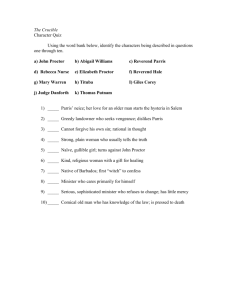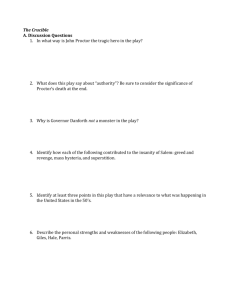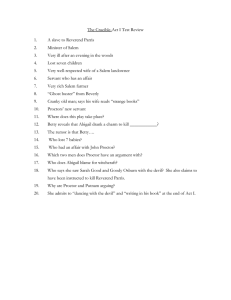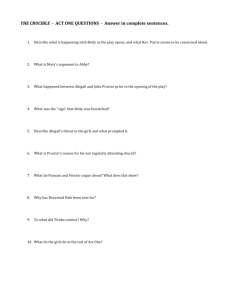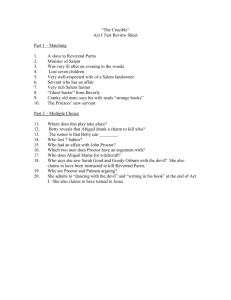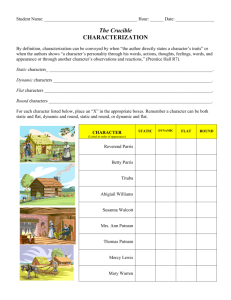the crucible and brilliant lies
advertisement
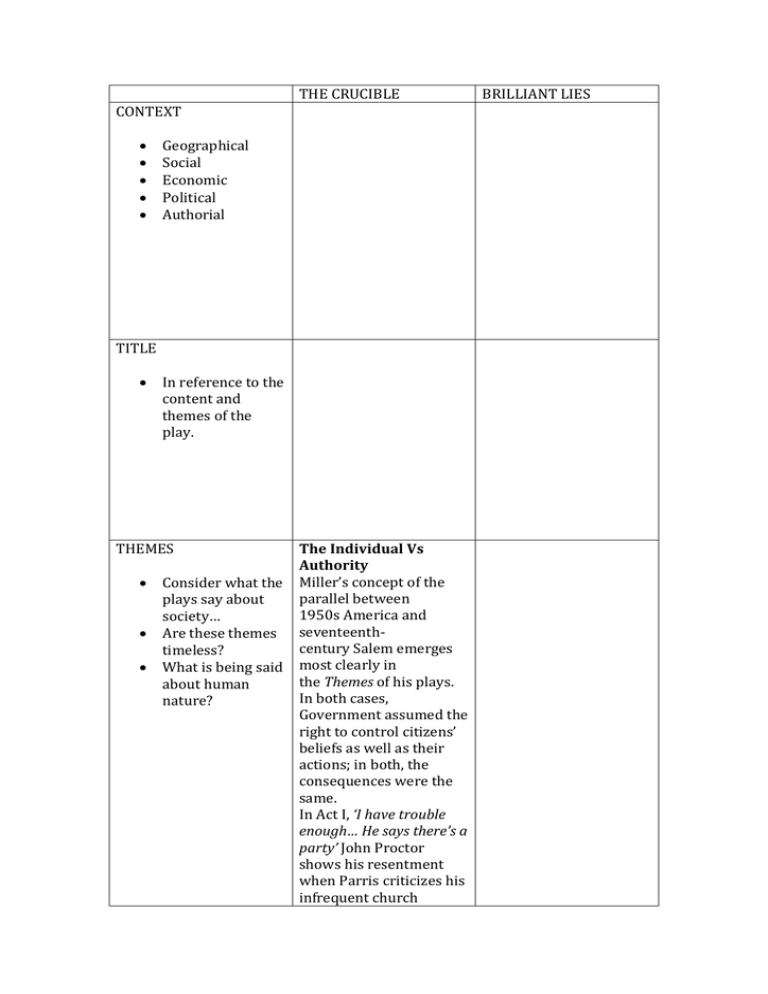
THE CRUCIBLE CONTEXT Geographical Social Economic Political Authorial TITLE In reference to the content and themes of the play. THEMES Consider what the plays say about society… Are these themes timeless? What is being said about human nature? The Individual Vs Authority Miller’s concept of the parallel between 1950s America and seventeenthcentury Salem emerges most clearly in the Themes of his plays. In both cases, Government assumed the right to control citizens’ beliefs as well as their actions; in both, the consequences were the same. In Act I, ‘I have trouble enough… He says there’s a party’ John Proctor shows his resentment when Parris criticizes his infrequent church BRILLIANT LIES attendance. He is absent for practical reasons— Elizabeth’s illness, his own work, and no doubt the ten-mile walk. He feels Parris does not deserve respect. Rebecca, more obedient, knows that Parris is unworthy, but is still shocked by John’s remarks. Reverend Hale later reprimands him for daring to question Parris’s God-given authority. Act II demonstrates the helplessness of people who try to stand up for their rights, literally in a theocratic state and metaphorically in society. Once the witchhunt has started, the potential for conflict escalates. Anyone who doubts the so-called evidence is questioning God’s will. The judges’ handling of the trial relates more to corruption of justice. They cling so inflexibly to their point of view that law-abiding characters like Rebecca and Francis Nurse are pushed into defiance. Even Hale, an establishment figure, finds he is unable to ignore his conscience. He finally denounces the court. Those whose honesty is stronger than their fear of death inevitably destroy themselves. Society and beliefs are stronger than the individual. Rebecca refuses to damn her soul with a lie; Giles values his land more than his life, and willingly accepts a horrible death. The Corruption of Justice Reverend Hale discovers the first ‘witch’ – Tituba – without any judicial enquiry at all. The first barrier against an unbiased examination of evidence is literally the close association of Church and State. Metaphorically though it is societal ideologies that condemn thought that does not conform to the zeitgeist of the time. The Effects of Fear Mr. Parris is afraid that his rebellious Parishioners will use Betty’s strange illness to oust him from his position; Abigail fears that Reverend Hale will find out what she did in the forest; so she embarks on an elaborate hoax that almost destroys the village. Ashamed to confess his affair with Abigail, John Proctor speaks up too late. This is only to say that the villagers of Salem are like people everywhere – they have secrets to hide and worry about their reputations. SYMBOLISM The entire play The Crucible can therefore be seen as a symbol of the hysterical antiCommunism of the early 1950s, though it should not be seen as only a symbol. The themes it defines and explores are timeless and applicable beyond the time and place in which they were written or set. Kettle When Reverend Parris discovers his niece, Abigail, and daughter, Betty, dancing in the woods with several other girls and the slave Tituba, Tituba is standing over a boiling kettle. This insinuates a traditional vision of witchcraft, and Abigail is later questioned what was in the kettle and if any creatures were put in it. Abigail admits that a frog leapt in, but of its own accord. Barbados The slave of Reverend Parris, Tituba, comes from the island of Barbados. She is a symbol of ‘otherness’ and societal fear of difference. This is why she is the first accused of being a witch. Books In Act I, Giles Corey questions Reverend Hale, "Mr. Hale, I have always wanted to ask a learned man - what signifies the readin' of strange books?" (Act I, p. 40). Giles continues to explain his wife has a strange habit of reading, but does not reveal what books she reads. Later in the play, this fact will be used against Martha Corey as basis of accusations of witchcraft. Knowledge is a symbol of something to be feared. It is not the ‘truth’ that is sought – it is the appearance of ‘truth’ and a desire to control society. Setting The court – symbolic of society – it is representative of the desire to appear to be rather than to be. The homes – symbolic of how societal rules and beliefs pervade all aspects of society. ABIGAIL Characters are stereo-types and represent an aspect of society PROCTOR Abigail Williams is the vehicle that drives the play. Abigail is the antithesis of Elizabeth. She rebels against all societal constructs of propriety. Dramatic irony for the audience because as she appears in the play as a character of upstanding morality. Abigail is symbolic of the individual who discards all social norms and this is what leads to her downfall. His best possession is his good name and the respect and integrity associated with it. Once he acknowledges his affair with Abigail, Proctor effectively brands himself an adulterer and loses his good name. He represents the importance of reputation in society. His indiscretion ironically demonstrates his goodness At the end of the play, Proctor refuses to slander himself by allowing the court to nail his false confession to the church door. This action further exemplifies Proctor's integrity. SETTING In reading or watching the play, the strongest viewpoint is relayed through the character of John Proctor. It is Proctor's voice with whom the audience is directed to sympathize with, and whose inner struggles cause the greatest tension. However, due to the naturalistic nature of Miller's writing, he includes no monologues to the audience or obvious exposition. The history of the characters, setting and plot are related through dialogue alone. THE OPENING OF THE PLAY ARE EXTENSIVELY DESCRIBED THROUGH THE AUTHOR’S NOTES. The setting is therefore central in symbolising the society being reflected. As the setting is raw, so is the behaviour of human beings. The effects of this raw colonial setting can be seen in Abigail's description of her parents' murder: "I saw Indians smash my dear parents' heads on the pillow next to mine" (Act I, p. 20). The Literal setting is established as Salem, Massachusetts, and the characters depicted in the play were Puritans. The Massachusetts government was dominated by conservative Puritan secular leaders prior to the 1680s. As the author notes in the text, "It was, however, an autocracy by consent, for they were united from top to bottom by a commonly held ideology whose perpetuation was the reason and justification for all their sufferings" (Act I, p. 6). This metaphorically implies that society is its own worst enemy – we support beliefs in society despite their detrimental impact. LANGUAGE AND MEANING Arthur Miller's language in The Crucible is suited to its characters, time and place. More formal than contemporary speech, the dialogue spoken by the characters reflects the formality within Puritan society during the 1600s in the American colonies. Likewise, there are distinctions between the way upper class characters, such as Deputy Governor Danforth and Judge Hawthorne, speak versus their lower-class constituents. Miller employs metaphor, simile and symbolism through his dialogue, in examples such as in Abigail's lines to Proctor: "I know how you clutched my back behind your house and sweated like a stallion whenever I come near! Or did I dream that?" (Act I, p. 22), and "I have a sense for heat, John, and yours has drawn me to my window, and I have seen you looking up, burning in your loneliness. Do you tell me you've never looked up at my window?" (Act I, p. 23). STRUCTURE The Crucible is an allegorical play set in four acts. Allegory is a literary device which communicates its message by means of symbolic figures, actions or metaphor. As such, the drama may be seen as an extended metaphor representing the era of McCarthyism and the "witch hunts" that it entailed during the 1950s. The Crucible follows the structure of classical tragedies, exemplified both in the clear distinctions of hero and villain, and in the structure of the play itself. The exposition takes place in the beginning of Act I, where the events of Reverend Parris discovering the girls dancing in the woods are described through dialogue. The rising action begins with the first accusations of witchcraft, and builds to a climax in Act III, when Proctor attempts to save Elizabeth in court. The falling action of the drama is illustrated as Mary is overcome by Abigail's power in the court, and the denouement takes place in the jail cell at the end of the play.
